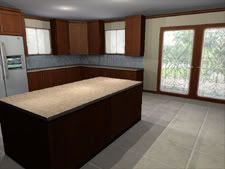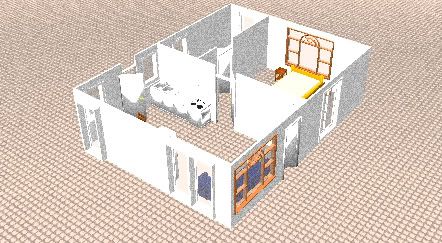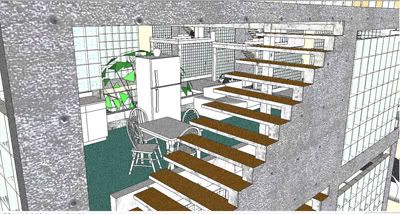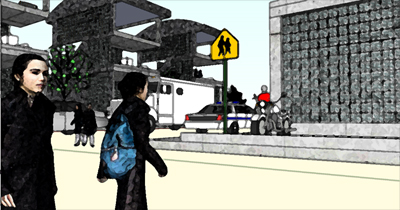Friday, December 26, 2008
reference: encyclopedia of architecture
Posted by rhaj at 6:55 AM 0 comments
Labels: architecture, reference
Sunday, December 14, 2008
review: decline of the west
spengler in his treatise saw through historical philosophy the perception of each people's culture embedded in its archaic forms.
the ancient egyptian, the chinese, the greek, the hindu, the gothic, the renaissance...saw what it was for a time that was then clearly expressed in form. in each time, they either turned inward and/or outward. each saw what was for a time a clarity before the world changed/evolved ...not as a model of the world itself but of that specific cultures' world...
the chinese temple following the principles of the tao of lao tzu(travelling through the world unrestricted by stone-walls) was not a free-standing building in itself but one that included hills, trees, streams, the wind and nature itself... the complex tones of baroque music, the emotional depth in the paintings of the realist rembrandt, the elliptical orbits of the planets reflected in the gothic cathedral (the magical forces evidently bringing light outside into its cool interiors through its stained glass windows)...the discovery of the calculus... greek temple design, greek vase painting, greek sculpture( the emergence of his bodily self as the differentiation of the individual from society...standing alone, free, and apart)...these are just some of the more influential forces within each period.
the renaissance architect, alberti, upon mastering the art of perspective, exclaimed. "now, i can see the world as god sees it"...for example...neither do we see the disc on the back of four elephants atop a giant tortoise swimming in an endless sea...which was how the ancient hindu saw the world...a manifestation in form of that culture's world... the order of their existence... the underlying principles...the way of life and death for that matter. a virtual view, an intangible presence in our imaginations...manifesting brilliance of the human race.
then the physics of einstein( theory of relativity...the bending of light in optics as it travels in a vacuum through space influenced by planetary gravitational forces), the novels of frost and joyce, the paintings of the cubists, the philosophy of heidegger's being ..turned the world into a flux to emerge in a relativistic-existential space-time...
Posted by rhaj at 4:29 PM 0 comments
Labels: philosophy, review
Saturday, November 29, 2008
reference: decline of the west II
Posted by rhaj at 7:28 PM 0 comments
Labels: architecture, reference, spengler
Thursday, July 31, 2008
DOCS: Architect's Law of 2004
Posted by rhaj at 11:08 PM 0 comments
Labels: architects law, R.A.9266
Sunday, June 8, 2008
DOCS: Criminal Complaint Form
Posted by rhaj at 8:04 PM 0 comments
Labels: complaint, docs, illegal practice
Tuesday, March 18, 2008
wikiHowTo: Home Design
----------------------------------------
If you've already decided to design as much of your home as you can without the help of an architect, this planning scenario takes you through the beginning steps required to gather the information, resources and examples necessary to enable you to design your own home. You will begin to see some of the required knowledge that goes into the planning of the home of your dreams. Whether it's building a new home or remodeling an existing one, both processes are exactly the same. Remodeling folks have additional burdens of starting with a box that limits them, but hopefully this will help!
Steps
- Get inspired. Planning your new home is the most critical moment of the process, and the most fun. Capitalize on the magical inspiration every project needs to make a house, a home - yours! Capture the lightning-in-a-bottle that motivates you in the first place to design your own home. Write it all down, keep a scrap book, bookmark pictures in books, take pictures, whatever your preferred method.
-
#*Write down every price quote, budget amount, phone number
- Take hundreds of pictures. Digital cameras make it cheap and easy. Shoot every angle of a building you like. You'll find more detail in the photos than you saw in person.
- Take hundreds of pictures. Digital cameras make it cheap and easy. Shoot every angle of a building you like. You'll find more detail in the photos than you saw in person.
-
- Keep a scrapbook of magazine articles, newspaper articles, business cards, etc. Begin compiling a list of every detail you like from your variousresources. The more information that you can provide to your architect or builder about paint colors, door hardware, plumbing fixtures, counter-tops, built-ins, stair details, appliances, etc. before you begin construction, the more likely you will hit your housing budget.
- Check out other examples of houses you like (friends, family, etc.) and learn about aspects of each.
- Keep a scrapbook of magazine articles, newspaper articles, business cards, etc. Begin compiling a list of every detail you like from your variousresources. The more information that you can provide to your architect or builder about paint colors, door hardware, plumbing fixtures, counter-tops, built-ins, stair details, appliances, etc. before you begin construction, the more likely you will hit your housing budget.
-
Get organized. You need documents that contain information you've gathered which serves to direct your planning efforts. Accurate documents focus attention on facts. Basic information eliminates "Pie-in-the-Sky" dream scenarios which waste time, effort and people's patience.
- Start with a Requirements List.
- Make a Wish List separately so that you can add it to your design later, as you find you can afford. Spend approximately 30 days to 6 months on this part.
- Find a scheme. You'll want to consider several different designs to find the scheme that best fits your needs. Schemes are freehand sketches drawn to capture the essence of a plan under consideration. They can be as simple as paper napkin sketches or professionally illustrated drawings. All are valid tools and each serves the purpose to convey a concept. This should take you about 3-6 months.
-
- Develop the design. This is the phase of the process where dimensions are added to the drawings. Everything must be made to fit at this phase. You will develop your scheme into a completely dimensioned drawing. With a conceptual design roughed out, scheme chosen, a theme decided upon and problems on the site ironed out, you are fitting all the pieces of the puzzle together in this step. You know you are done here when you have located on paper the location of every door and window in the house. This should take you approximately 2 months
-
- Pay a pro to draw a "Site Plan" of your property, including elevations. This will be helpful in balancing slopes, adding fill or making cuts to accommodate your dream home.
- ]]Let the steady hand of an experienced designer take over the process of shaping up the prints. If you've gotten this far on your own drawing skills, you need to delegate now. You have more important duties involved in managing your dream home.
- Draft plans. The takeaway from this step is a fully detailed set of plans that the city and construction workers will use to build your home.
Tips
- When you're starting out, put all your materials in folders and keep them in one cardboard box. When you find something, the cardboard box will be the place to put it and find it later on when you need it.
- Tools to use are simple pencil and paper and don't forget a ruler (or scale). Architects use "tissue paper" which can be found at any store that sells drafting supplies. A wooden kitchen cutting board makes an excellent drafting table! A whiteboard and erasable markers provide an excellent means to flesh out a design that is fast changing or incremental in its development. Nothing is better for getting everyone's input and involvement in a design than a whiteboard!
- A pair of scissors, glue stick and a photo copier are your best friend during the process of revising a plan. Cut and paste to your heart's content and copy!
- Take your time. Think about how you will use each space, the furnishings in the space, the circulation through and around the spaces, and what is most important about each space. Cut out measured paper shapes for furniture and cabinets and try them out to see how they will work with windows, doors and circulation paths through the space.
- Another idea is to find a friendly parking lot where you can pace out and chalk the rough dimensions of your house, including all rooms, doors and hallways. This gives you the opportunity to walk through your prospective home and really feel how the spaces relate to one another.
- If you are having a difficult time in visualizing a design, consider a 3D visualization studio. In these days, they can create a photo-realistic version of your interior or exterior. For more information, type in "architectural rendering" in a search engine. Currently, you can find some incredible studios in south Florida, New York City, and other major cities.
- Google SketchUp (free; see External Links) can be helpful in designing room layouts and for visualizing the final layout.
- Most of all, have fun!
Warnings
- Visit the City Planning and Zoning office before proceeding further. Find out what you can build on your property, where the setbacks are, how tall you can go, and what you may need a variance for.
- Avoid the mistake of bringing copies of plans into the very beginning of the process. Most important to the success of your design is giving the people involved in the process permission to just get it all out. Everyone has something that they want most out of the process. Don't ruin the chance to capture those thoughts, hopes and desires by distractingly focusing on the wrong things too early on. Get what you want out of this stage!
- Don't be afraid to talk to a professional about helping you out right from the beginning of this process. Most good residential architects will consult with you early on in the process for a minimal fee.
Related wikiHows
- How to Navigate the Home Building Process
- How to Make Blueprints
- How to Choose a Home Improvement Contractor
- How to Remodel a House
- How to Buy a Home
- How to Increase the Value of Your Home
- How to Succeed at Any Home Improvement Project
- improve all your work what you do and check everything you do.
Sources and Citations
Article provided by wikiHow, a collaborative writing project to build the world's largest, highest quality how-to manual. Please edit this article and find author credits at the original wikiHow article on How to Design Your Own Home. All content on wikiHow can be shared under a Creative Commons license.
Posted by rhaj at 9:00 AM 0 comments
Saturday, March 8, 2008
Virtual Space

Demo 1: This is a great example of space programmed in java. I like the stained-glass door the most. If there were more interactive features like the possibility of opening furnished objects then that would be really astounding! Indeed a great tool for presentations.
Demo 2
NextGen of webpages will never be the same again.
No installation.
No log-ins.
Just free and open spaces.
Hmm..inspiring!
Hint:
Navigate with mouse by click&drag.
forward-E
back-D
sidestep right-F
sidestep left-S
Posted by rhaj at 8:45 PM 0 comments
Labels: 3d models, flash, papervision, virtual worlds
Sweet Home 3D

Sample Test Project: It was modelled in less than thirty minutes. Not a very stiff learning curve, that is, if you have previous exposure to all other 3D softwares. This is screencapture on the 3d window. Modified on PhotoshopCS for sizing and filter. There's also an alternate toggle to a virtual visit camera view.
The software is a release from Sun's Netbeans. Still not very refined but very workable in terms of document transmissions. It exports data from the 3D model directly into a .PDF format including schematic diagrams and itemized furnish info.
(please click on blog title to go to it's homepage in order to download the software)
Posted by rhaj at 5:32 PM 0 comments
Labels: 3d solid models, CAD, java, modelling
Wednesday, March 5, 2008
A Trail of Corruption
Forget about the NBN deal or the new enactment to change the alphabet from ABC to ZTE. Let's focus on a lower intensity scenario like the Local Government Level.
The core of infrastructure projects is outlined in a document called the Land Use and Zoning Code/Ordinance(there is a need for local enactment). With it are prominently featured such departments like the City Engineer's Office and the City Planning office. Both mandatory departments under the Local Government Code of 1991, R.A. 7160, authored by Sen. Aquilino Pimentel.
That Local Government Code did not make the City Architect's Office mandatory but rather only discretionary or optional. The Architect's Law of 2004, also sponsored by the good senator, has the effect of making it a mandatory department.
The City Engineer's Office is tasked with enforcing the Zoning Ordinance. The issuance of a Building Permit is one of it's primary functions. Including the enforcement of demolition orders and all other functions provided by the building code, PD 1096 and its Implementing Rules and Regulations(IRR).
The power to issue a Notice of Illegal Construction is the first step towards a deeply rooted corrupt system. Through a network of organized operatives enumerated in the set of allied professions, like the electrical engineer, sanitary, mechanical, geodetic engineers. This group operates as a syndicate for captive client projects. At the center of this organized network is the Civil Engineer.
The processing of plans are made through established contacts within and outside the bureaucracy. This organized crime does not include the architect. An outsider in the game.This reminds me of my instructor in an Architectural Design subject, who exclaimed in class.." why do you all want to be architects? Don't you know that there is a very slim chance of success in the field?" hahaha! Times change sir.
This business provides the so called 'sideline' for most government employees who are technically oriented. Using government time, materials, and resources. To the detriment of the practicing architect. It is as if the government has competed with the private practitioner. These are all illegal projects because they are undocumented in the sense that they are not signed and sealed by their respective authors. They deny government income through proper documents that produce taxable contracts. Instead of benefiting the government, they end up filling the pockets of individual entities.
If the structure or the plan fails later, liability cannot attach for the reason that both parties are guilty. The owner for the illegal construction, and in the hope of getting a bargain through bribes and the professional for illegal practice who 'fixes it' at a bargain price. They just call it 'quits'. No guarantees. Ever wondered why our cities are littered with such failed projects?
The New Implementing Rules and Regulations hopes to cure that defect in the system. It has an effect of stopping the above-mentioned illegal business.
These illegal practices not only takes away the life-blood of government but also deprives the general citizenry of well planned environments and spaces. If you look around your neighborhood and sense a hostile environment unfit for human habitation then you know the cause of such a disease.
What is really at stake is the health of the nation. An unhealthy environment, ill conceived spaces,and irresponsible structures produce an unhealthy citizenry. In effect a poor country.
Posted by rhaj at 9:21 PM 0 comments
Labels: architect's law, Construction, Corruption, Land Use, Local government Code, P.D. 1096, Zoning
Friday, February 29, 2008
The Law Has Spoken, The Gentle Hammer Swings
This article is a 'coup de grace'.
The Petition for Declaratory Relief filed by the Civil Engineers through its national organization, the Philippine Institute of Civil Engineers (PICE), has been denied by the Regional Trial Court(RTC), Branch 22, Manila.
A moment of rejoicing and a vindication for the prejudice caused by the conflict of interest between the architects and the civil engineers.
For many decades now, the architects have been deprived of a fair deal in the industry. Construction has always been dominated by the engineers. Starting in the '50s right after the war. The enabling laws between what was supposed to be allied professions resulted in a scenario that went sour.
Driven by inhospitable conditions in the local scene, Filipino talent found its solace and manifestations in foreign lands. In Dubai, for example, which is dominated by Arch. Palafox, also the approved schemes for the new palaces of the kingdom of Saudi Arabia, another commissioned project. Need I mention too the palace of Brunei's Sultan, Bolkiah?
As a consolation, you can never blame the architects nor pin them down as a big player in the malignant disease of 'corruption' that has been plaguing the country. Starting with the 10% SOP(mind you, Lozada said: 20% was still acceptable), as pre-condition before a project is awarded to a contractor. Where does the businessman break even? In the quality of the finished product. Roads that don't last long, buildings and structures that fail or barely meet the minimum standards. Over-designed in plan yet just barely enough in actual construction.
Last January 29, 2008, Judge Marino de la Cruz made his decision.
There is really no conflict between R.A. 544 and R.A. 545. Including it's amending laws, R.A. 1581 and R.A. 1582, both issued in 1956, with regard to corporate practice, where either side was required to retain a minimum of one practitioner from the other profession (the new Architect's Law of 2004 requires 3/4 from among the incorporators), that is to enable corporate practice. Which later, was modified to mean that either can do without the other. Again, the danger of modifying substantial laws.
In 1970, PD 1096 or the National Building Code was implemented. It was established, through the records of the case, as an uncontested/incontrovertible fact that the original law signed and published in the Official Gazette was modified in the actual code published for commercial distribution. That being made a basis for M.O. 057. The civil engineer, in simplest of terms, anchored their case on a 'fraudulent act'. There can never be a vested right based on a fraud. Time cannot make a wrong thing right no matter how long they have been practiced. "FRAUS ET JUS NUNQUAM COHABITANT".
According to my research, this was during the time when the then Public Works Minister(1981-1982), Engr. Jesus Hipolito was being perceived as a 'little president,' he had full access to Malacanang, the seat of power. He was probably entertaining the idea that he would become the next president of the Republic. The criminally intelligent Marcos, had a way of dealing with his minions. The brilliant Marcos, gave false hopes that he was grooming future successors. They in turn gave him a certain degree of loyalty.These loyal henchmen were his new breed of oligarchs.
Its been more than 30 years since then, until now the country still staggers from the oppressive yoke of an authoritarian-dictatorial-fascism regime.Why? They were able to amass large amount of wealth and capital. People like D.M. Consunji and F.F.Cruz had some form of monopoly during that time, they were industry leaders. The practice was extended to our time because the culture of corruption never ended with Marcos. It even got worse because they could not "moderate their greed".
Maybe its high time that we cut clean from the infections of the past.
Posted by rhaj at 7:33 AM 0 comments
Labels: architect's law, architecture, decisions, fraud
Saturday, February 16, 2008
Friday, February 15, 2008
Exploring Google SketchUp

DETAIL: stairway: dine, kitch, live
URBAN SETTING: preliminary entourage(unedited)
Multiple insertion of typical residential model rendered with PhotoshopCS lens filter.
Urban landscape scenario still in the works...
Basic Model
note: you need SketchUp to download and walk-tru/tour the unit.
___________________________
review: it's a good piece of software. i haven't found a bug yet, so far, and it's not the full version.
its workable, interface is intuitive. most proly good for collaborative work considering its inter-operability with google earth.
Imagine gazing through Google Earth like that top image..magnificent!
Posted by rhaj at 2:41 PM 0 comments
Labels: 3d solid models, architecture, CADD, design, sketchup


